HORYU-4, 2.4GHz received

HORYU-4 2.4GHz received by JE9PEL
My System: HGL2429(Loop 29ele), GR-2400(Amp), GRX-2402D(Converter)
GRX-2402D: Gain=+28dB, 56.4MHzx40=2256MHz, IF=2400-2256=144.000MHz
05:22-05:34 UTC, 20 Feb 2016, Ele 40 WS-S-E, 2400.300MHz 100kbps BPSK
http://www.dropbox.com/s/yg41q64m69dnitc/60220hr4.wav?dl=0
I heard and saved as a wav file of 2400.300MHz 100kbps BPSK signal from HORYU-4.
The signal are visible on both sides +/- 50kHz of 2400.300MHz of the nominal
frequency in HORYU-4.
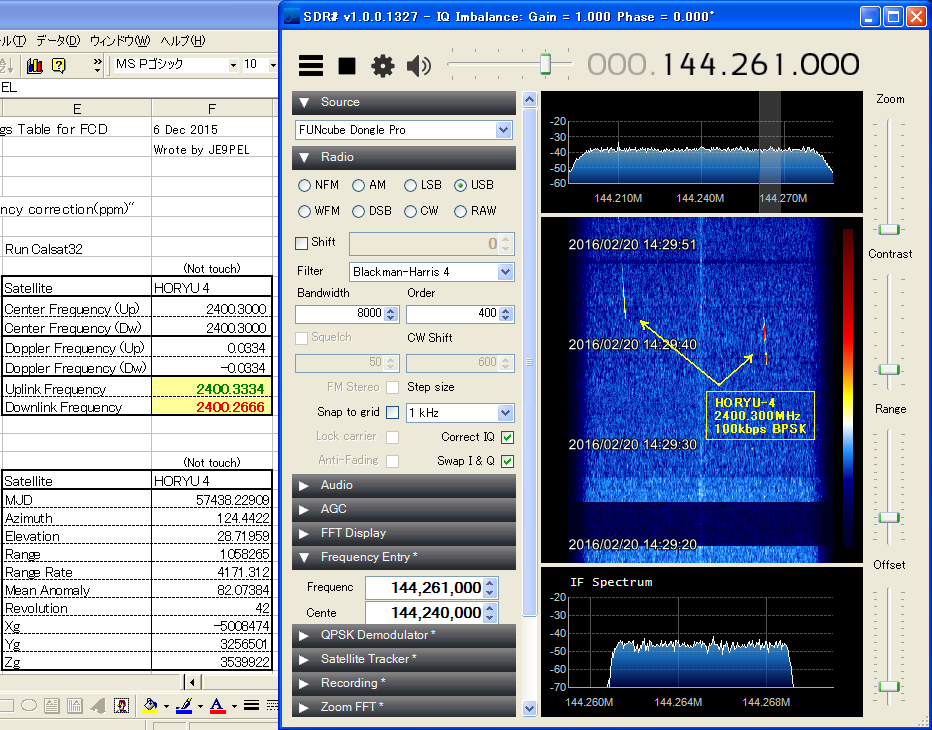
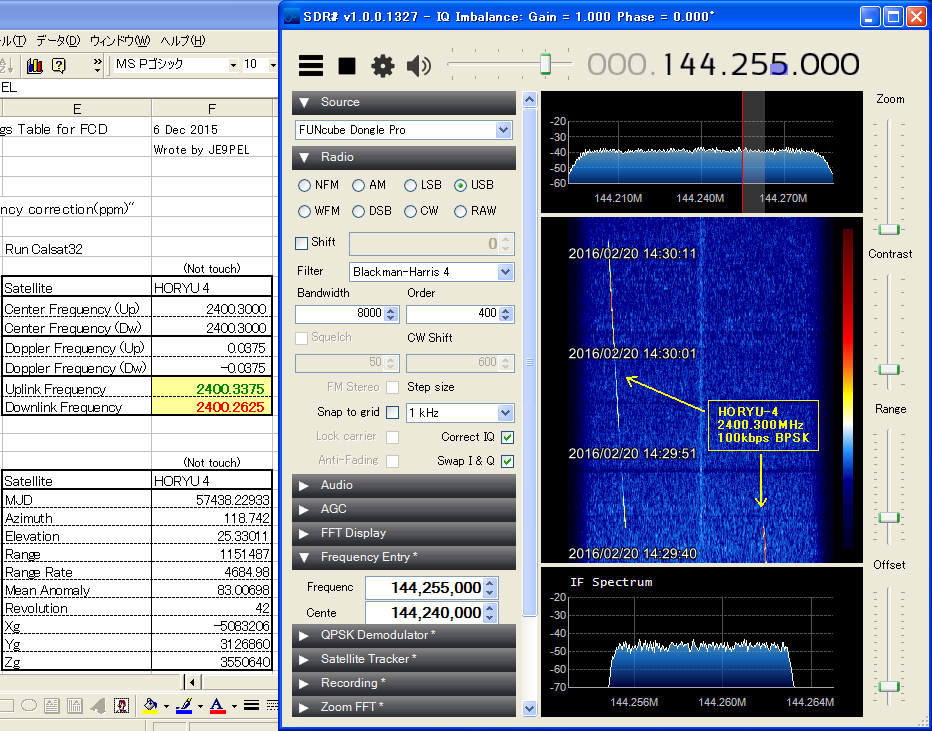
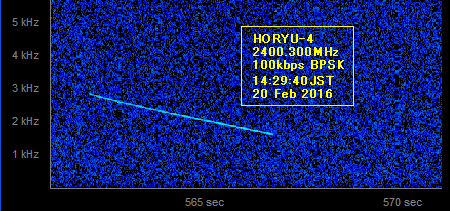 HORYU-4 2.4GHz spurious signal received by JE9PEL
07:03-07:16 UTC, 20 Feb 2016, Ele 45 W-S-SE, 2400.250MHz 100kbps BPSK
I heard 2.4GHz signal many times in this orbit. The spurious signal will
be heard lower than about 50kHz from the nominal frequency, it may sound
rather strongly. The followings are the image that I received this real
signal and spurious signal. At the 2400.250 MHz, I heard the clear and
stable sound of them. Perhaps it might not be a spurious signal.
This deviation signal might be the real signal of HORYU-4 2.4GHz.
HORYU-4 2.4GHz spurious signal received by JE9PEL
07:03-07:16 UTC, 20 Feb 2016, Ele 45 W-S-SE, 2400.250MHz 100kbps BPSK
I heard 2.4GHz signal many times in this orbit. The spurious signal will
be heard lower than about 50kHz from the nominal frequency, it may sound
rather strongly. The followings are the image that I received this real
signal and spurious signal. At the 2400.250 MHz, I heard the clear and
stable sound of them. Perhaps it might not be a spurious signal.
This deviation signal might be the real signal of HORYU-4 2.4GHz.
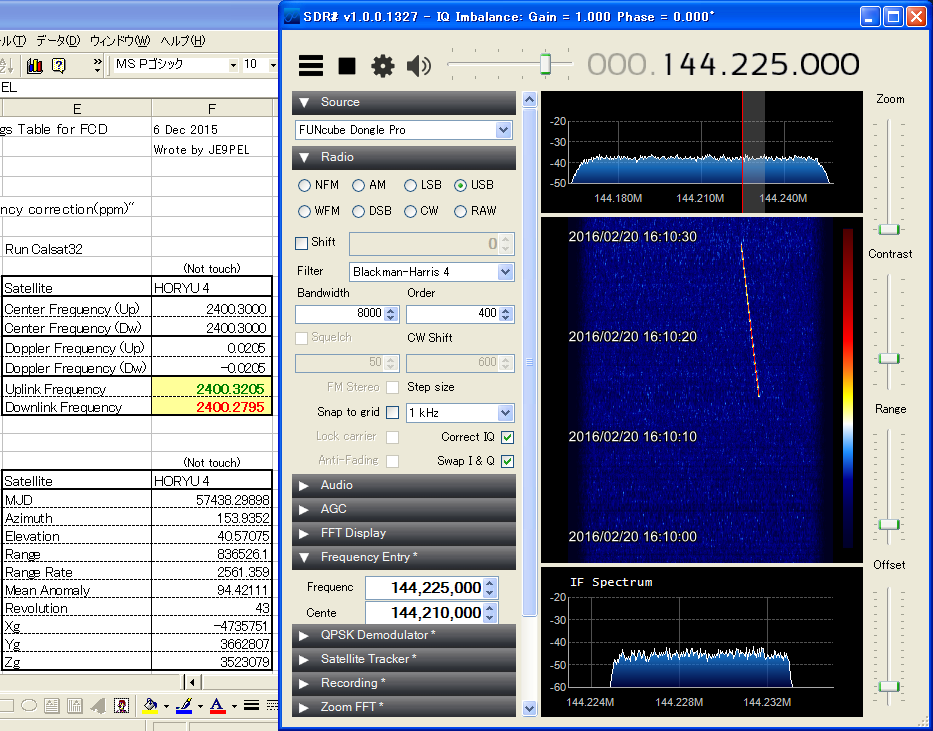 [NOTE] The true configuration of +/- 50kHz was became clear by
the ground station of HORYU-4 was explained as follows.
It was the true signal, it's not the spurious signal.
> When it transmit a continuation signal (50kHz) such as 01010101010...
> changing in 100kbps, there are the sharp mountain such as a carrierin
> on both sides +/- 50kHz of 2400.300MHz of the nominal frequency of
> 2400.3MHz. After this state continued for 15 seconds or 30 seconds,
> the gentle mountain centered on the 2400.3MHz (occupied bandwidth is
> about 150kHz) is visible. The radio mode is a continuous BPSK signal.
> The pre-ambled data of 0x555 and scrambled data are output in turn
> in that signal. These signal outputs by the following procedures.
> The signal are transmitting continually until the end (unlike UHF).
>
> 1. It output the pre-amble signal for 30 seconds.
> 2. It output the scrambled signal for 0.3 seconds.
> 3. It output the pre-amble signal for 0.05 seconds.
> 4. It comes back to 2. after repeating this 2.~3, 64 times.
> 5. It comes back to 2. after outputing pre-amble for 15 seconds.
> 6. It comes back to 1. after repeating this 5. four times.
HORYU-4 IQ.wav received by JH1OKL
07:03-07:16 UTC, 20 Feb 2016, Ele 45 W-S-SE, 2400.300MHz +/-50kHz
I replayed the IQ.wav received by JH1OKL. The signal are visible on
both sides +/- 50kHz of 2400.300MHz of the nominal frequency in HORYU-4.
In the right figure below, I received it at 2400.300MHz + 50kHz = 2400.350MHz.
There are the three PDF files as "S-band decoder software, S-band data format,
S-band data analysis" in the server of the ground station. I feel like it's
difficult to analyze the received data.
[NOTE] The true configuration of +/- 50kHz was became clear by
the ground station of HORYU-4 was explained as follows.
It was the true signal, it's not the spurious signal.
> When it transmit a continuation signal (50kHz) such as 01010101010...
> changing in 100kbps, there are the sharp mountain such as a carrierin
> on both sides +/- 50kHz of 2400.300MHz of the nominal frequency of
> 2400.3MHz. After this state continued for 15 seconds or 30 seconds,
> the gentle mountain centered on the 2400.3MHz (occupied bandwidth is
> about 150kHz) is visible. The radio mode is a continuous BPSK signal.
> The pre-ambled data of 0x555 and scrambled data are output in turn
> in that signal. These signal outputs by the following procedures.
> The signal are transmitting continually until the end (unlike UHF).
>
> 1. It output the pre-amble signal for 30 seconds.
> 2. It output the scrambled signal for 0.3 seconds.
> 3. It output the pre-amble signal for 0.05 seconds.
> 4. It comes back to 2. after repeating this 2.~3, 64 times.
> 5. It comes back to 2. after outputing pre-amble for 15 seconds.
> 6. It comes back to 1. after repeating this 5. four times.
HORYU-4 IQ.wav received by JH1OKL
07:03-07:16 UTC, 20 Feb 2016, Ele 45 W-S-SE, 2400.300MHz +/-50kHz
I replayed the IQ.wav received by JH1OKL. The signal are visible on
both sides +/- 50kHz of 2400.300MHz of the nominal frequency in HORYU-4.
In the right figure below, I received it at 2400.300MHz + 50kHz = 2400.350MHz.
There are the three PDF files as "S-band decoder software, S-band data format,
S-band data analysis" in the server of the ground station. I feel like it's
difficult to analyze the received data.
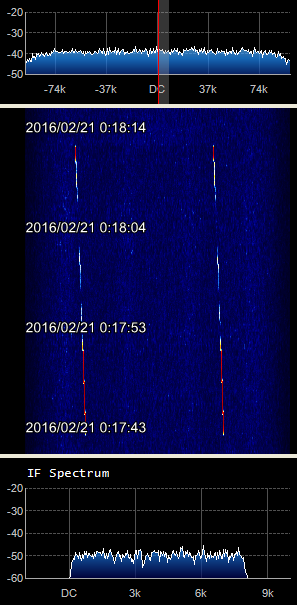
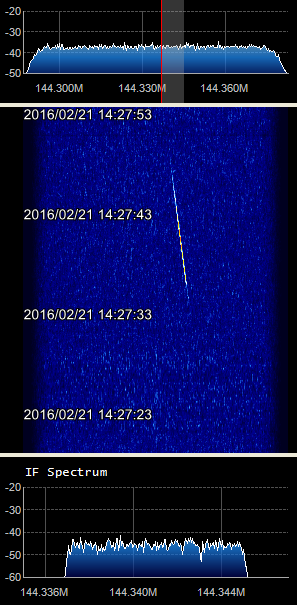 HORYU-4 gentle mountain 2.4GHz
received by JH1OKL, 05:17-05:29 UTC, 26 Feb 2016, Ele 33 deg, 2400.300MHz
received by JA0CAW, 03:35-03:47 UTC, 27 Feb 2016, Ele 45 deg, 2400.300MHz
I, JE9PEL confirmed a gentle mountain centered on the 2400.3MHz
in the following images using these two IQ.wav files.
HORYU-4 gentle mountain 2.4GHz
received by JH1OKL, 05:17-05:29 UTC, 26 Feb 2016, Ele 33 deg, 2400.300MHz
received by JA0CAW, 03:35-03:47 UTC, 27 Feb 2016, Ele 45 deg, 2400.300MHz
I, JE9PEL confirmed a gentle mountain centered on the 2400.3MHz
in the following images using these two IQ.wav files.
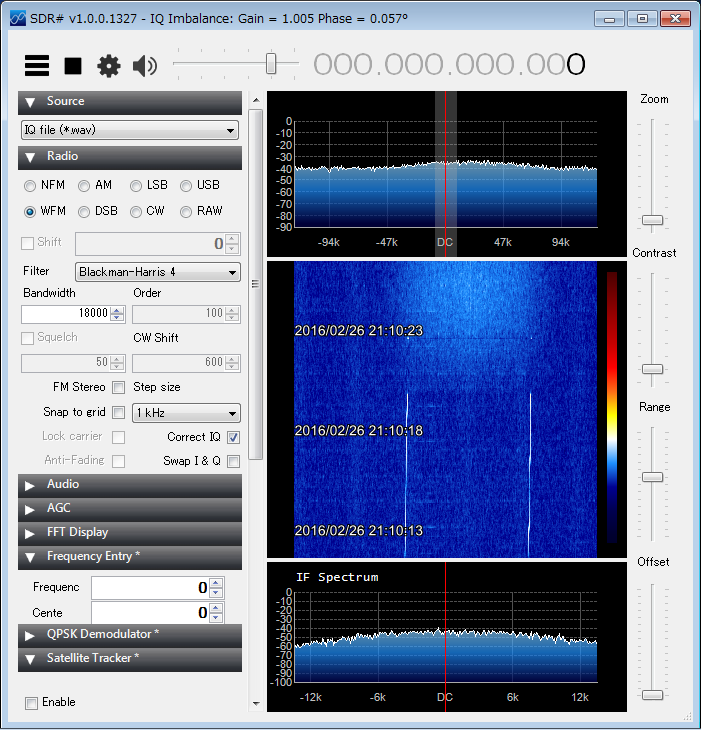
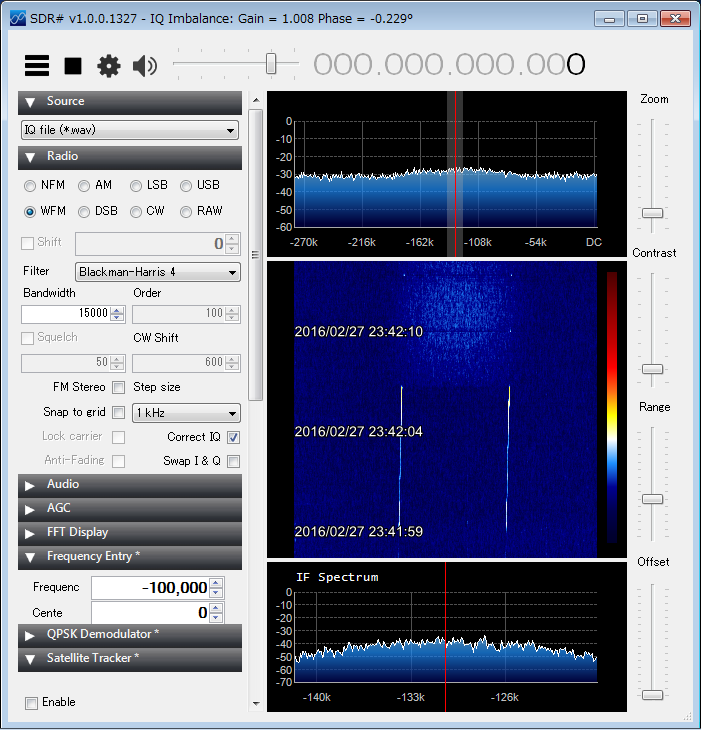 HORYU-4 center and both_sides signal received by JE9PEL
01:53-01:05 UTC, 27 Feb 2016, Ele 38 WS-S-E, 2400.300MHz center carrier
05:16-05:28 UTC, 27 Feb 2016, Ele 27 W-S-SE, 2400.300MHz +/-50kHz sides
00:06-00:18 UTC, 05 Mar 2016, Ele 45 W-S-SE, 2400.300MHz beautiful signal
HORYU-4 center and both_sides signal received by JE9PEL
01:53-01:05 UTC, 27 Feb 2016, Ele 38 WS-S-E, 2400.300MHz center carrier
05:16-05:28 UTC, 27 Feb 2016, Ele 27 W-S-SE, 2400.300MHz +/-50kHz sides
00:06-00:18 UTC, 05 Mar 2016, Ele 45 W-S-SE, 2400.300MHz beautiful signal
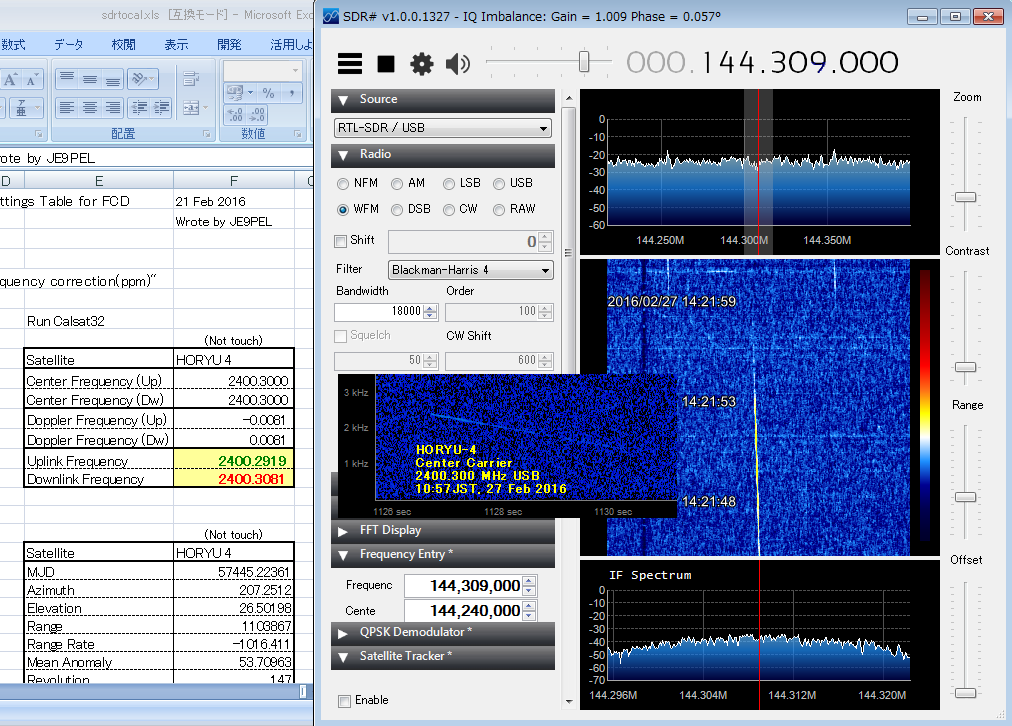
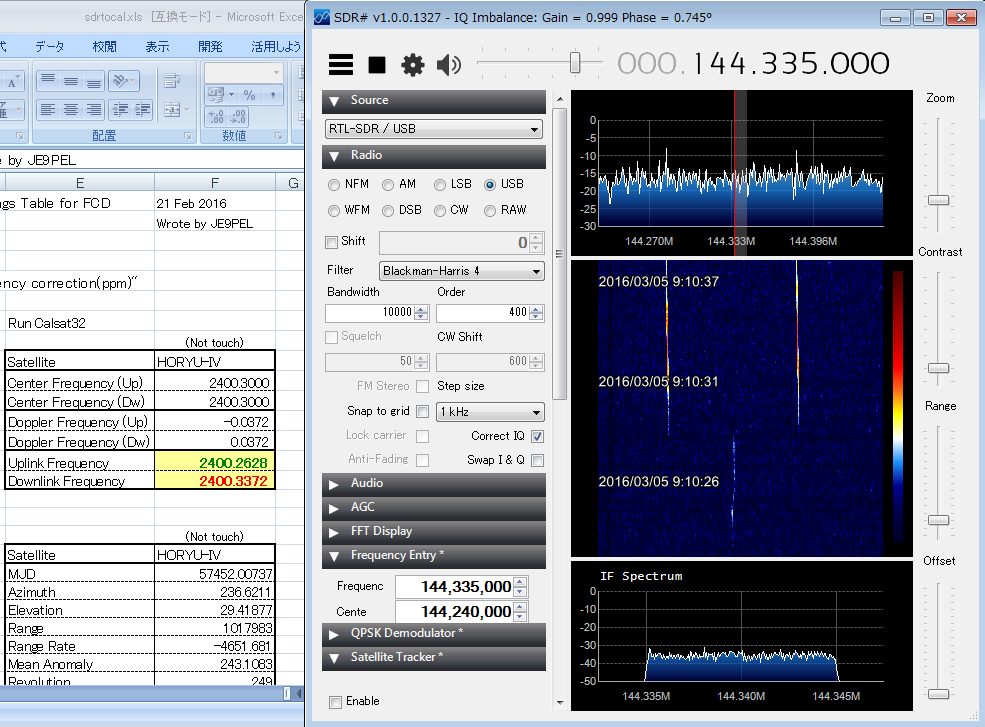 HORYU-4 2.4GHz stream
Win7 + RTLSDR + SDR#1327
00:05-00:17 UTC, 6 Mar 2016, Ele 43 W-S-SE, 2400.300MHz 100kbps BPSK
HORYU-4 2.4GHz stream
Win7 + RTLSDR + SDR#1327
00:05-00:17 UTC, 6 Mar 2016, Ele 43 W-S-SE, 2400.300MHz 100kbps BPSK
 HORYU-4 very strong 2.4GHz
11:19-11:31 UTC, 20 May 2016, Ele 42 W-S-SE, 2400.300MHz USB
HORYU-4 very strong 2.4GHz
11:19-11:31 UTC, 20 May 2016, Ele 42 W-S-SE, 2400.300MHz USB
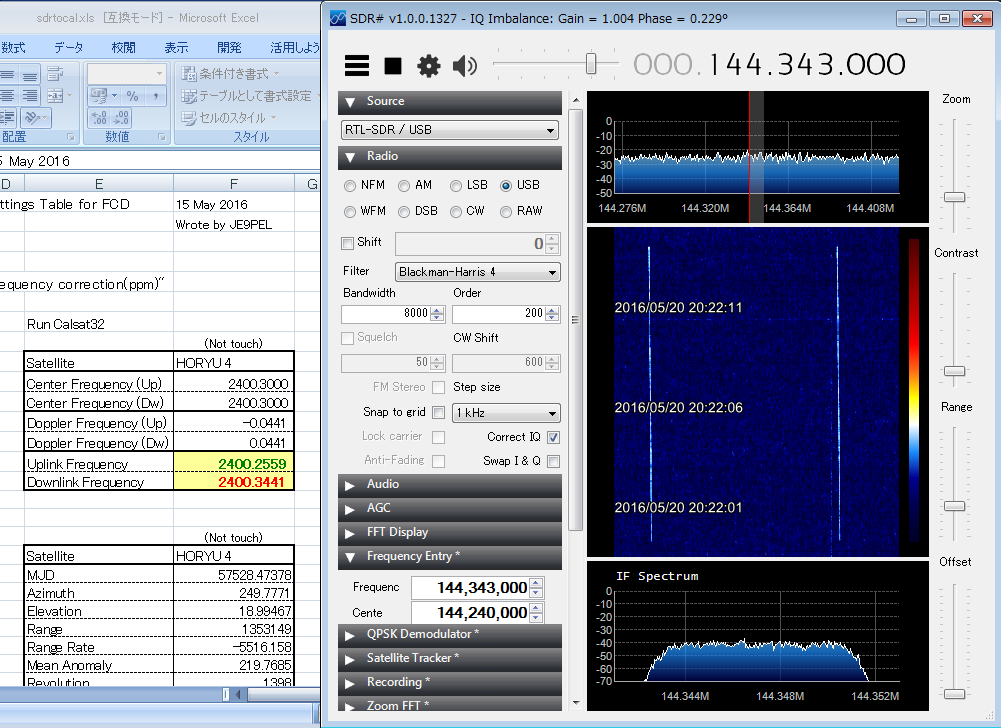
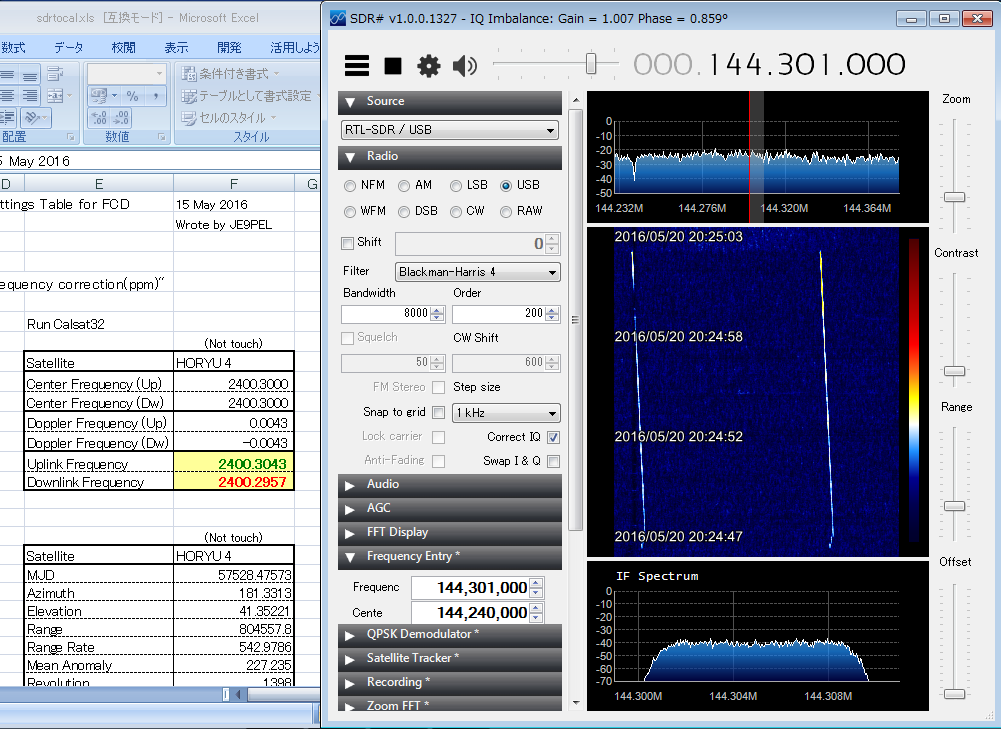
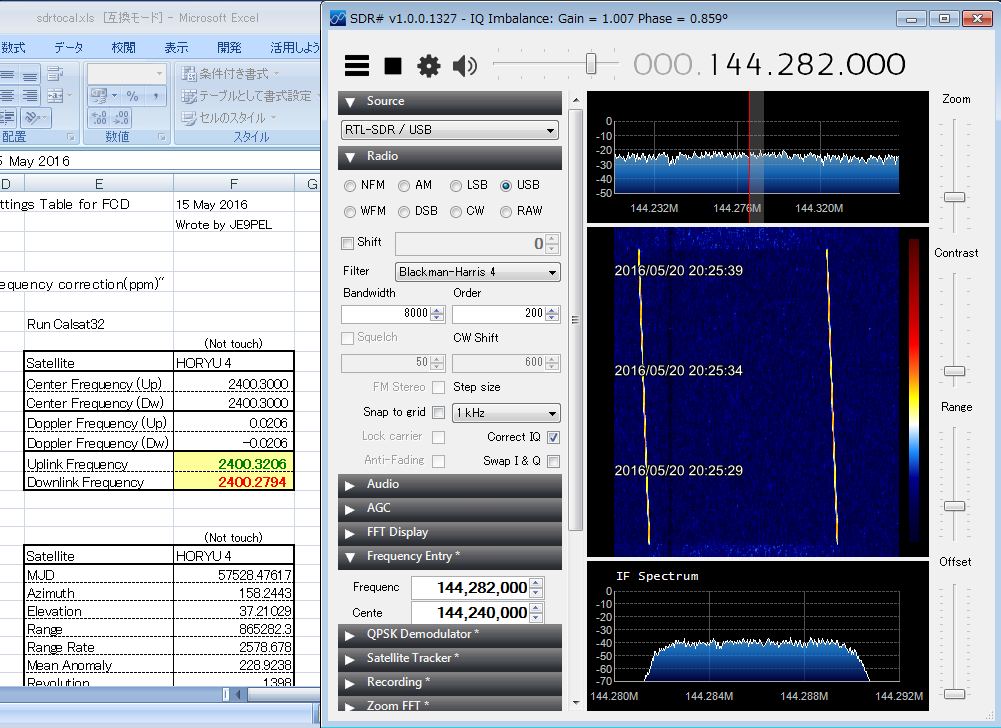
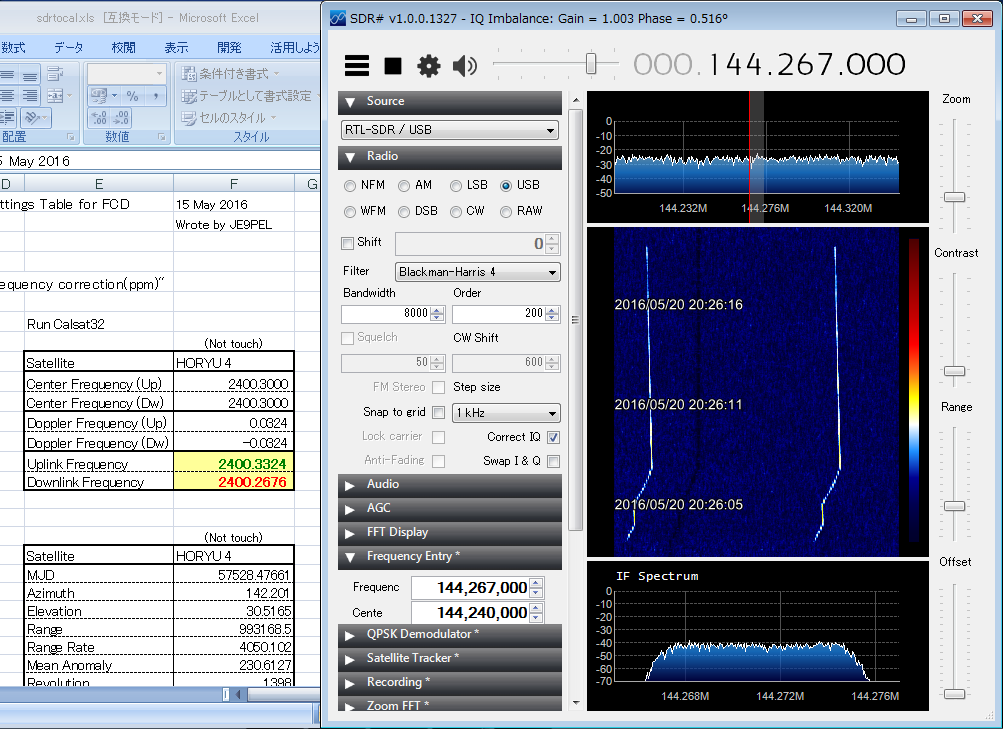 HORYU-4 S-BPSK upper_sideband
09:34-09:46 UTC, 23 May 2016, W-S-SE, 2400.300MHz+50kHz BPSK
60523hr2.wav (upper_sideband)
60523h22.png (Spectrogram16)
60523h23.png (Spectran216)
HORYU-4 S-BPSK lower_sideband
00:52-01:04 UTC, 05 Jun 2016, WS-S-E, 2400.300MHz-50kHz BPSK
60605hr4.wav (lower_sideband)
60605hr4.png (Spectran216)
HORYU-4 S-BPSK upper_sideband
09:34-09:46 UTC, 23 May 2016, W-S-SE, 2400.300MHz+50kHz BPSK
60523hr2.wav (upper_sideband)
60523h22.png (Spectrogram16)
60523h23.png (Spectran216)
HORYU-4 S-BPSK lower_sideband
00:52-01:04 UTC, 05 Jun 2016, WS-S-E, 2400.300MHz-50kHz BPSK
60605hr4.wav (lower_sideband)
60605hr4.png (Spectran216)
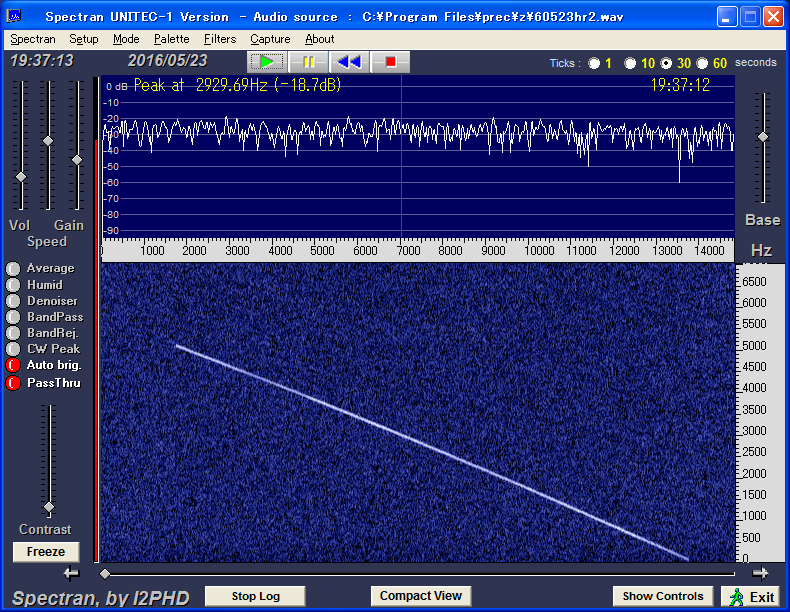
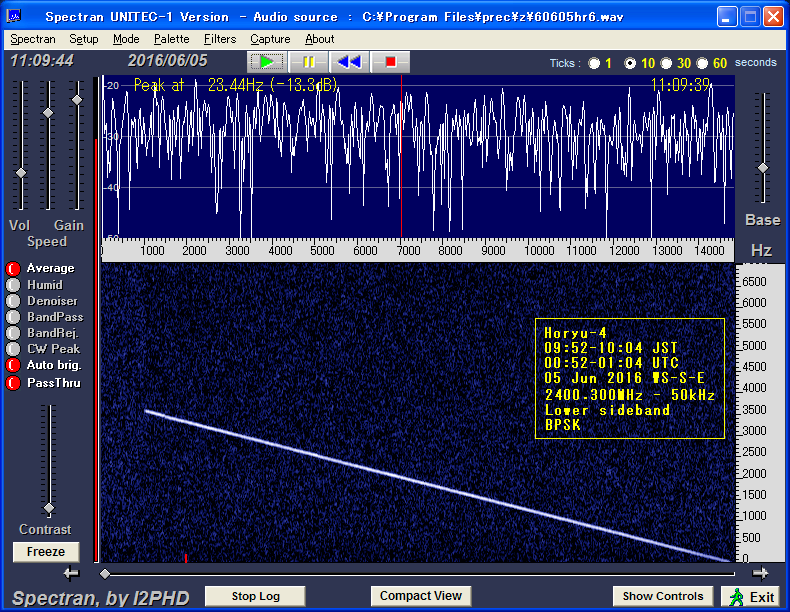
 Back to Top
Back to Top
 Back to Home Page
Back to Home Page




HORYU-4 2.4GHz spurious signal received by JE9PEL 07:03-07:16 UTC, 20 Feb 2016, Ele 45 W-S-SE, 2400.250MHz 100kbps BPSK I heard 2.4GHz signal many times in this orbit. The spurious signal will be heard lower than about 50kHz from the nominal frequency, it may sound rather strongly. The followings are the image that I received this real signal and spurious signal. At the 2400.250 MHz, I heard the clear and stable sound of them. Perhaps it might not be a spurious signal. This deviation signal might be the real signal of HORYU-4 2.4GHz.
[NOTE] The true configuration of +/- 50kHz was became clear by the ground station of HORYU-4 was explained as follows. It was the true signal, it's not the spurious signal. > When it transmit a continuation signal (50kHz) such as 01010101010... > changing in 100kbps, there are the sharp mountain such as a carrierin > on both sides +/- 50kHz of 2400.300MHz of the nominal frequency of > 2400.3MHz. After this state continued for 15 seconds or 30 seconds, > the gentle mountain centered on the 2400.3MHz (occupied bandwidth is > about 150kHz) is visible. The radio mode is a continuous BPSK signal. > The pre-ambled data of 0x555 and scrambled data are output in turn > in that signal. These signal outputs by the following procedures. > The signal are transmitting continually until the end (unlike UHF). > > 1. It output the pre-amble signal for 30 seconds. > 2. It output the scrambled signal for 0.3 seconds. > 3. It output the pre-amble signal for 0.05 seconds. > 4. It comes back to 2. after repeating this 2.~3, 64 times. > 5. It comes back to 2. after outputing pre-amble for 15 seconds. > 6. It comes back to 1. after repeating this 5. four times. HORYU-4 IQ.wav received by JH1OKL 07:03-07:16 UTC, 20 Feb 2016, Ele 45 W-S-SE, 2400.300MHz +/-50kHz I replayed the IQ.wav received by JH1OKL. The signal are visible on both sides +/- 50kHz of 2400.300MHz of the nominal frequency in HORYU-4. In the right figure below, I received it at 2400.300MHz + 50kHz = 2400.350MHz. There are the three PDF files as "S-band decoder software, S-band data format, S-band data analysis" in the server of the ground station. I feel like it's difficult to analyze the received data.

HORYU-4 gentle mountain 2.4GHz received by JH1OKL, 05:17-05:29 UTC, 26 Feb 2016, Ele 33 deg, 2400.300MHz received by JA0CAW, 03:35-03:47 UTC, 27 Feb 2016, Ele 45 deg, 2400.300MHz I, JE9PEL confirmed a gentle mountain centered on the 2400.3MHz in the following images using these two IQ.wav files.

HORYU-4 center and both_sides signal received by JE9PEL 01:53-01:05 UTC, 27 Feb 2016, Ele 38 WS-S-E, 2400.300MHz center carrier 05:16-05:28 UTC, 27 Feb 2016, Ele 27 W-S-SE, 2400.300MHz +/-50kHz sides 00:06-00:18 UTC, 05 Mar 2016, Ele 45 W-S-SE, 2400.300MHz beautiful signal

HORYU-4 2.4GHz stream Win7 + RTLSDR + SDR#1327 00:05-00:17 UTC, 6 Mar 2016, Ele 43 W-S-SE, 2400.300MHz 100kbps BPSK
HORYU-4 very strong 2.4GHz 11:19-11:31 UTC, 20 May 2016, Ele 42 W-S-SE, 2400.300MHz USB



HORYU-4 S-BPSK upper_sideband 09:34-09:46 UTC, 23 May 2016, W-S-SE, 2400.300MHz+50kHz BPSK 60523hr2.wav (upper_sideband) 60523h22.png (Spectrogram16) 60523h23.png (Spectran216) HORYU-4 S-BPSK lower_sideband 00:52-01:04 UTC, 05 Jun 2016, WS-S-E, 2400.300MHz-50kHz BPSK 60605hr4.wav (lower_sideband) 60605hr4.png (Spectran216)

